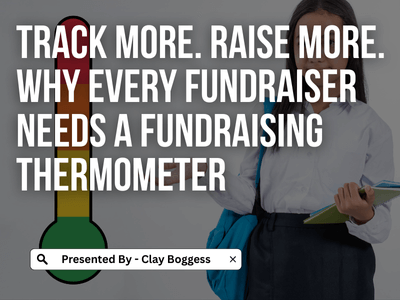
Make more money with compelling, donor-centric fundraising letters.
Fundraising programs are known by many for the hallmark “direct mail” letter or solicitation phone call. While much of school fundraising product sales occur within a student’s circle, a personally written letter can still be an impactful way to make an ask or thank a donor for their participation. Consider also that sending out an email or letter before you start going door-to-door can “warm up” your donors so that your product sales do not become a series of cold calls.
Still, despite communicating through the written word more than most recent generations due to the text-message revolution, many people fear writing a letter—especially one that will go out to dozens of friends, family members, and colleagues.
We’ve discussed the idea of donor-centric fundraising before, but we’ll unpack how these same principles of cultivating your support can be translated into a single written communication that:
- Is focused on the donor’s impact;
- Has opportunities for adding personal touches;
- Is easy to read and understand; and
- Demonstrates gratitude.
Good Fundraising Letters Focus on Impact
The first few lines of a donor letter are your most important, since in those 8-10 seconds, a reader will either go, “Oh, this is nice. I’m glad I am giving/will give to this,” or “Great, another ask!”
Tell the donor what they did (or can do) right out of the gate to avoid the eye roll. Consider openers like:
- “You made a difference this year.”
- “You changed lives with your generosity.”
- “You made my school a better place to be.”
- “You can make sure I’m prepared to succeed.”
Notice anything? All of these statements directly address the donor right out of the gate. The direct address is a powerful tool that should be used sparingly, but it engages the donor immediately because they instantly become a character in your story.
When encountering a statement like this, the brain is wired to want to know more. The donor will want to know exactly how they made a difference through tangible examples. That means you should follow up your attention-grabbing opening line with examples of how this impact was made or what their impact will look like: “Because of you, ten students got books they wouldn’t have otherwise had.”
Don’t be afraid to use anecdotes, facts, figures, and even graphics to show rather than tell. Remember, it’s your job to collapse the space between purchasing a product and better outcomes in education.
Good Fundraising Letters are Personal
Gone are the days when every envelope was hand-addressed. Marketing automation has lulled us all into a false sense of personalization. A good fundraising letter must stand out from the masses of mail your friends, family, and neighbors get by having strikingly personal touches.
For school fundraisers or other small grassroots fundraisers, the number of asking/thanking letters any single fundraiser is responsible for should be relatively limited, so personalizing them will be manageable. These custom additions to each letter don’t need to be anything extraordinary, but donors should be able to tell that you took the time to think of them.
So, how do you stand out?
- Handwrite the address. Nothing will get someone’s attention in the mail more (short of a colored envelope) than a handwritten address. It immediately lets the donor know this is a personal message.
- Make sure the salutation includes the donor’s name. No “Dear Sir or Ma’am.”
- Sign your name. How many printed signatures have you received that look blurry and unprofessional? A signed letter adds a sense of gravitas because it shows you intentionally endorsed the messages.
- Include a personal note. Writing 10-30 custom letters is unrealistic, but using a form letter with a personal note on an inserted card will make them feel extra special.
Every letter should feel like it’s received a little TLC from the sender. Think of these as the “nonverbal cues” of writing; you must find unique ways to show the reader the intent and meaning behind the written words.
Good Fundraising Letters are Easy to Read
Making a letter easy to read is a primarily technical matter. As a rule of thumb, adhere to those classic standards: at least 12 pt. font and no more than one page unless you have a good reason to make it longer.
Beyond that, look out for nonprofit jargon. Sterile language can quickly erode the human element that makes your fundraising letter compelling. People want to see a real-life change in people, not a real fiscal improvement in an organization. If there are terms like “value proposition”, “cultivation,” or “systemic improvement,” find a new way to express that idea or consider if it’s even essential to include for this audience.
Generally, you should aim to write to an 8th to 10th-grade audience. Tons of free online tools can help you gauge where you fall. Hemingway is an entertaining tool that will help you clean up your writing quickly and give you a sense of how difficult or easy your letter is to read.
Good Fundraising Letters Express Gratitude
There’s not much to this one. Include a heartfelt, sincere message of gratitude (something more than “Thank you”) at the beginning and end of your letter and anywhere else it seems relevant in between. The most vital letters will include quotes from beneficiaries of your services.
Implementing all these tips requires practice while still getting your important message across. Ask other volunteers to edit and look specifically for these elements. You’ll find that priming your audience with these messages before making an ask will make it easier to have that face-to-face conversation and that sending a thank you letter will make them more likely to come back next year.
Author Bio
Clay Boggess has been designing fundraising programs for schools and various nonprofit organizations throughout the US since 1999. He’s helped administrators, teachers, and outside support entities such as PTAs and PTOs raise millions of dollars. Clay is an owner and partner at Big Fundraising Ideas.



